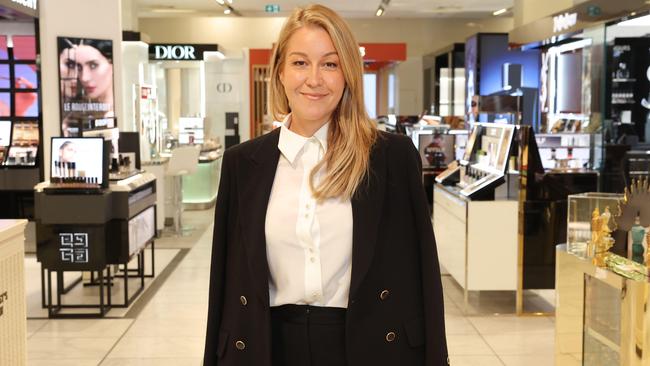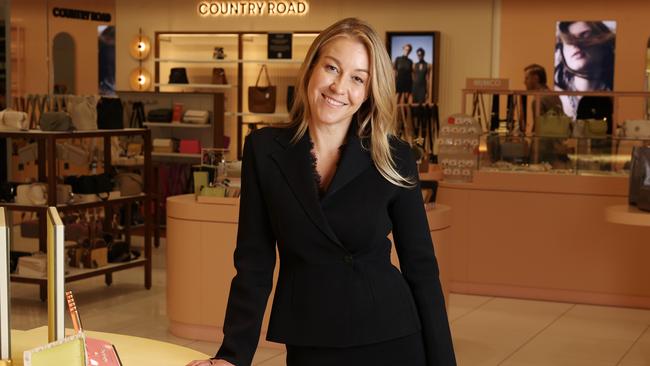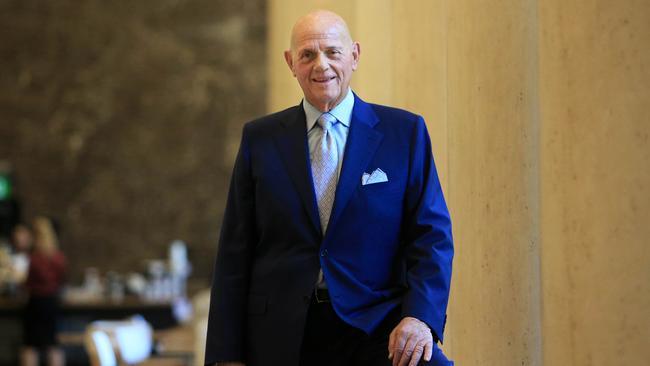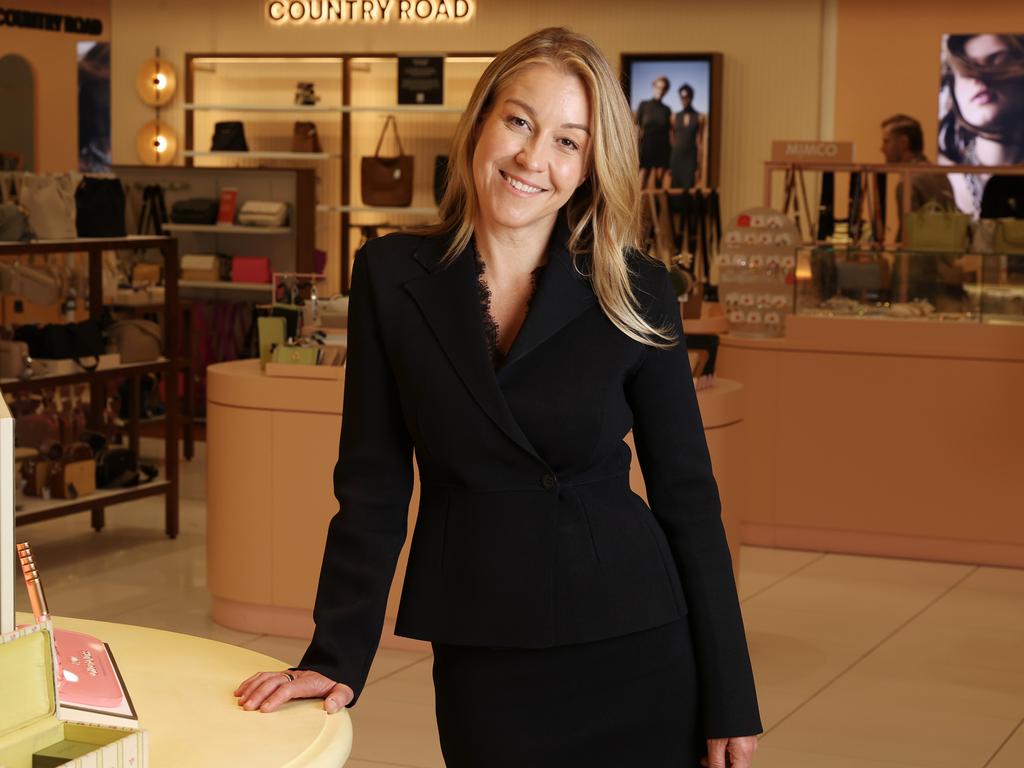Olivia Wirth’s big Myer plan: discipline, data … and stopping thieves
Myer’s recently appointed executive chairman Olivia Wirth has revealed her strategy to return the department store to growth, after the company reported a hefty slide in net profit.

Myer boss Olivia Wirth will leverage her years of running the highly profitable Qantas loyalty scheme to transform the Myer One program into a significant asset that grows well beyond the department store to become a leading national shopping rewards platform.
Ms Wirth, the recently appointed executive chairman of Myer, has provided an early glimpse into her planned transformation of the retailer, departing from more than two decades of almost unchanged annual sales levels, and she sees Myer One as central to shifting the chain to sustainable profit growth.
“I would also say that there is an opportunity to broaden the Myer One program and to truly become a loyalty ecosystem, to take Myer One beyond Myer and truly become an established retail ecosystem in Australia,” Ms Wirth said.
Titled “Myer tomorrow”, the plan was revealed as Ms Wirth presented the company’s full-year results on Friday.
The former Qantas executive pinpointed a string of initiatives – such as fighting in-store theft, improving the beauty offer, expanding the private label range and building up Myer One as a powerful earnings funnel – to improve the retailer’s performance.
Ms Wirth has now reset the agenda for the 124-year-old retailer’s operations, aiming to generate better returns for investors and become more relevant to consumers.
“It (the strategy) is very much focusing on obviously improving the performance, improving the profitability, delivering shareholder returns at the same time really delivering for our customer, understanding their pain points and rethinking what the future is for Myer,” Ms Wirth told The Weekend Australian after Myer posted a 28 per cent slide in net profit to $43.5m, after more than $12m in impairments and tough trading conditions hit earnings.
Myer shares fell almost 10 per cent as the result was announced, but rebounded to end almost unchanged at 87c.

“(It’s) about being relevant. It’s about being relevant to the customer, about being relevant to a broad range of customer segments across Australia. This is where the opportunity is, because the market is not sedentary, it doesn’t stay the same, it is constantly changing,” Ms Wirth said.
“And our opportunity here is how do we lean into that change, and how do we reorientate the growth, and how do we rethink the business so that we can reorientate for growth over the next five years.”
As part of that reorientation Ms Wirth is considering a bid for Solomon Lew’s retail apparel businesses – Portmans, Just Jeans, Jay Jays, Jacqui E and Dotti – which are owned by the billionaire’s Premier Investments.
A deal would hand Myer almost $850m in extra sales and more than 700 stores to sit alongside its 56 department stores.
Ms Wirth said on Friday that negotiations and due diligence were under way. She insisted Myer could run hundreds of standalone fashion stores despite it shutting down stores it owns under its sass & bide fashion label.
“When I think about the (Premier Investments) apparel brands … I think we have been pretty clear what the strategic intent is for apparel brands and why we believe the business will deliver returns for our shareholders and also be a very attractive proposition for our customers as well,” she said. “It gives us scale, it gives us diversification, and importantly it gives us the capacity to leverage Myer One beyond the existing base.”
Ms Wirth is battling a worsening trading environment for the retail sector.
Sales for the full-year were down 2.9 per cent to $3.226bn.
The trading update accompanying the results threw a greater spotlight on the economic headwinds, with sales in the first seven weeks of fiscal 2025 up just 0.2 per cent versus the corresponding period in the prior year. “Today’s result reflects the challenging macroeconomic environment for Australian retailers,” Ms Wirth said.
“Despite the tougher trading conditions, work undertaken by the Myer team in recent years has helped stabilise the business and established a foundation for future growth. With a highly engaged customer base, a leading loyalty program, positive comparable department store sales growth and high levels of trust in the Myer brand, there are significant opportunities for growth.”

The Myer full-year results – largely due to former CEO John King, who departed earlier this year – showed a 26 per cent fall in profit before restructuring and impairments to $52.6m for the 12 months to July 27.
The weaker statutory net profit after tax of $43.5m included $9.1m ($12.2m pre-tax) of impairments and restructuring costs for its sass & bide, Marcs and David Lawrence brands.
The retailer said comparable sales for fiscal 2024 were up 0.4 per cent while online sales of $704.3m were up 2 per cent. Underlying profit margins fell 12 basis points, reflecting sales mix changes, while operating gross profit fell 2.5 per cent to $1.194bn.
Myer declared a final dividend of 0.5c per share, down from 1c, payable on November 21.
The “Myer tomorrow” strategy revealed as part of the company’s full-year results will seek to increase customer engagement in its Myer One program and attract more male and younger shoppers, to give Myer a greater “share of wallet”.
Ms Wirth said her digital strategy would focus on using data to personalise offers to Myer shoppers and improve Myer’s e-commerce platforms. A new focus on profits and margins would see Myer more disciplined on costs, how it spent its promotional budget, cut down theft and made its supply chain more efficient.
Naturally, given her background in running loyalty programs – she built the Qantas loyalty scheme into a significant and profitable asset – Ms Wirth has big plans for Myer One. It currently has 10.4 million members, up 706,000 in 2024, with more than half aged under 35.
“Where the opportunity is for us is to how do we invest in the right aspects of this Myer One program so that we can do more with our with our data, so that we better understand the true customer insights about what are the products that they want, what are the pain points that we are solving for, and what are the channels that they choose to shop in,” she said. “And how do we better personalise that experience for them, because then we can truly win in the omni-channel environment.”






To join the conversation, please log in. Don't have an account? Register
Join the conversation, you are commenting as Logout